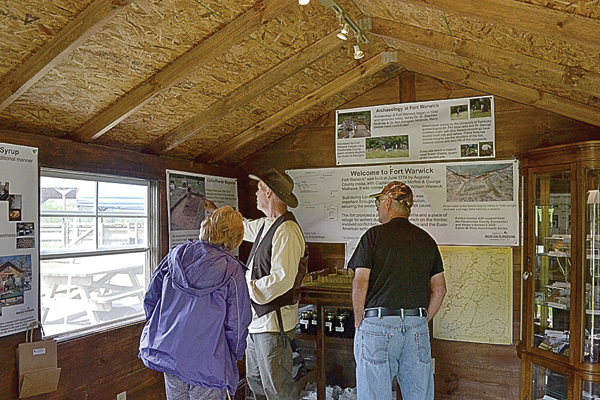
Suzanne Stewart
Staff Writer
In 1774, a Virginia Militia fort was built in Green Bank by George Moffatt’s and George Matthews’ companies. It was named Fort Warwick and served as a refuge for settlers until 1783.
In 2004, Warwick family descendant and Green Bank resident Bob Sheets – who owns the land on which the fort was built – used a metal detector on the site to see if there was anything to be discovered.
Since then, Sheets and his family and archeologists Drs. Steven and Kim McBride, of the University of Kentucky program of Archaeological Research, have held multiple digs at the site to discover the foundation of the fort, as well as artifacts including buckles, buttons, ceramic fragments and a glass fob carved with the profile of King George III.
And now, 18 years after that first probe into the site, Sheets welcomed guests again to the property last Saturday for the grand opening of the Fort Warwick Museum.
It’s a cozy little building, but it contains a large amount of county history and even grander finds from the property’s exploration.
The building was purchased from Jennalee Meck, who sells storage units for Wagler Enterprises, of Beverly.
“Jennalee had this sitting on the lot over there, and I thought, ‘we can do something with this,’” Sheets said. “I thought, ‘it’s kind of a country cabin, has a rustic feel.’”
With the help of his sons, Jake and Jed, Sheets finished the inside and wired it for electricity. The museum has a curio cabinet, which contains the delicate and intriguing artifacts – including the glass fob, which is one of the most significant discoveries to date.
Next to the cabinet, is a long bureau-type display case, which has a small model of what the fort looked like, as well as reading material about the history of the fort and the time period it was active.
The walls are decorated with banners of information about past archeological digs, as well as the Sheets family history – including the family’s hobby of making maple syrup.
Fort Warwick maple syrup, shirts and hats are for sale in the museum.
Since the first dig in 2005, there have been thousands of visitors who have participated in uncovering the history of the area, including Pocahontas County students.
“That’s one of the things I’m really most proud of – twelve hundred students have come through and had an archeological experience and learned some history along the way,” Sheets said.
It may be a small building now, but from humble beginnings come greater things and Sheets said there is always room to grow.
“We want people to understand the level of what we’ve uncovered and hopefully, we’ll find some more today to add to that.”



